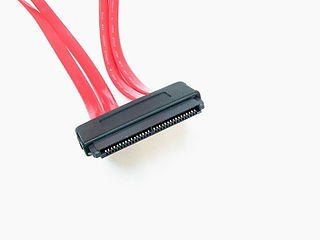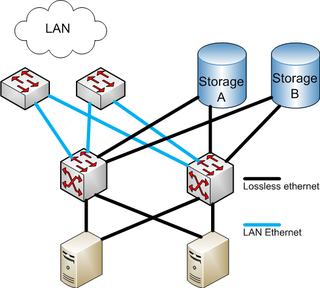External links
- SCSI Trade Association – Official website
The SCSI Trade Association, or SCSITA (sometimes STA), is an industry trade group which exists to promote the use of SCSI technology. It was formed in 1996. As of 2012 [update] , sponsor members include HP, Intel, LSI Logic, PMC-Sierra, and Seagate. [1] Requirements for membership are (1) manufacturing or selling SCSI related products or services and (2) paying dues and fees, which start at $4500/year. [2]
The SCSITA does not define SCSI technical standards; that is the job of the INCITS T10 Committee. [3] Rather, SCSITA promotes the use of SCSI and establishes standard marketing terminology and trademarks. They also foster vendor inter-operability. [4]

Parallel ATA (PATA), originally AT Attachment, also known as ATA or IDE is standard interface designed for IBM PC-compatible computers. It was first developed by Western Digital and Compaq in 1986 for compatible hard drives and CD or DVD drives. The connection is used for storage devices such as hard disk drives, floppy disk drives, and optical disc drives in computers.

Small Computer System Interface is a set of standards for physically connecting and transferring data between computers and peripheral devices. The SCSI standards define commands, protocols, electrical, optical and logical interfaces. The SCSI standard defines command sets for specific peripheral device types; the presence of "unknown" as one of these types means that in theory it can be used as an interface to almost any device, but the standard is highly pragmatic and addressed toward commercial requirements. The initial Parallel SCSI was most commonly used for hard disk drives and tape drives, but it can connect a wide range of other devices, including scanners and CD drives, although not all controllers can handle all devices.
Fibre Channel (FC) is a high-speed data transfer protocol providing in-order, lossless delivery of raw block data. Fibre Channel is primarily used to connect computer data storage to servers in storage area networks (SAN) in commercial data centers.

Serial ATA is a computer bus interface that connects host bus adapters to mass storage devices such as hard disk drives, optical drives, and solid-state drives. Serial ATA succeeded the earlier Parallel ATA (PATA) standard to become the predominant interface for storage devices.

The Storage Networking Industry Association (SNIA) is a registered 501(c)(6) non-profit trade association incorporated in December 1997. SNIA has more than 185 unique members, 2,000 active contributing members and over 50,000 IT end users and storage professionals. The SNIA absorbed the Small Form Factor Committee.

In computing, Serial Attached SCSI (SAS) is a point-to-point serial protocol that moves data to and from computer-storage devices such as hard disk drives and tape drives. SAS replaces the older Parallel SCSI bus technology that first appeared in the mid-1980s. SAS, like its predecessor, uses the standard SCSI command set. SAS offers optional compatibility with Serial ATA (SATA), versions 2 and later. This allows the connection of SATA drives to most SAS backplanes or controllers. The reverse, connecting SAS drives to SATA backplanes, is not possible.
STA or Sta may refer to:
The InterNational Committee for Information Technology Standards (INCITS),, is an ANSI-accredited standards development organization composed of Information technology developers. It was formerly known as the X3 and NCITS.

Parallel SCSI is the earliest of the interface implementations in the SCSI family. SPI is a parallel bus; there is one set of electrical connections stretching from one end of the SCSI bus to the other. A SCSI device attaches to the bus but does not interrupt it. Both ends of the bus must be terminated.
ISO/IEC JTC 1, entitled "Information technology", is a joint technical committee (JTC) of the International Organization for Standardization (ISO) and the International Electrotechnical Commission (IEC). Its purpose is to develop, maintain and promote standards in the fields of information and communications technology (ICT).
The introduction of Serial Attached SCSI (SAS) as the most recent evolution of SCSI required redefining the related standard for enclosure management, called SCSI Enclosure Services. SES-2, or SCSI Enclosure Management 2 first revision, was introduced in 2002 and is now at revision 20. SES-2 SCSI Enclosure Services (SES) permit the management and sense the state of power supplies, cooling devices, LED displays, indicators, individual drives, and other non-SCSI elements installed in an enclosure. SES2 alerts users about drive, temperature and fan failures with an audible alarm and a fan failure LED.

Fibre Channel over Ethernet (FCoE) is a computer network technology that encapsulates Fibre Channel frames over Ethernet networks. This allows Fibre Channel to use 10 Gigabit Ethernet networks while preserving the Fibre Channel protocol. The specification was part of the International Committee for Information Technology Standards T11 FC-BB-5 standard published in 2009.
In computing the SCSI RDMA Protocol (SRP) is a protocol that allows one computer to access SCSI devices attached to another computer via remote direct memory access (RDMA). The SRP protocol is also known as the SCSI Remote Protocol. The use of RDMA makes higher throughput and lower latency possible than what is generally available through e.g. the TCP/IP communication protocol. Some network adapters accelerate RDMA onboard, such as InfiniBand HCAs and Ethernet network adapters with RDMA over Converged Ethernet (RoCE) or iWARP support while some software such as Vcinity implement them in software for WAN transport.

Serial ATA International Organization (SATA-IO) is an independent, non-profit organization which provides the computing industry with guidance and support for implementing the SATA specification. SATA-IO was developed by and for leading industry companies. It was officially formed in July 2004 by incorporating the previous Serial ATA Working Group which had been established in February 2000 to specify Serial ATA for desktop applications.
SCSI / ATA Translation (SAT) is a set of standards developed by the T10 subcommittee, defining how to communicate with ATA devices through a SCSI application layer. The standard attempts to be consistent with the SCSI architectural model, the SCSI Primary Commands, and the SCSI Block Commands standards.

USB Attached SCSI (UAS) or USB Attached SCSI Protocol (UASP) is a computer protocol used to move data to and from USB storage devices such as hard drives (HDDs), solid-state drives (SSDs), and thumb drives. UAS depends on the USB protocol, and uses the standard SCSI command set. Use of UAS generally provides faster transfers compared to the older USB Mass Storage Bulk-Only Transport (BOT) drivers.

In computing, Linux-IO (LIO) Target is an open-source implementation of the SCSI target that has become the standard one included in the Linux kernel. Internally, LIO does not initiate sessions, but instead provides one or more Logical Unit Numbers (LUNs), waits for SCSI commands from a SCSI initiator, and performs required input/output data transfers. LIO supports common storage fabrics, including FCoE, Fibre Channel, IEEE 1394, iSCSI, iSCSI Extensions for RDMA (iSER), SCSI RDMA Protocol (SRP) and USB. It is included in most Linux distributions; native support for LIO in QEMU/KVM, libvirt, and OpenStack makes LIO also a storage option for cloud deployments.
ATA Packet Interface (ATAPI) is a protocol that has been added to Parallel ATA and Serial ATA so that a greater variety of devices can be connected to a computer than with the ATA command set alone. It carries SCSI commands and responses through the ATA interface. ATAPI devices include CD-ROM and DVD-ROM drives, tape drives, magneto-optical drives, and large-capacity floppy drives such as the Zip drive and SuperDisk drive.
Object storage is a computer data storage that manages data as objects, as opposed to other storage architectures like file systems which manages data as a file hierarchy, and block storage which manages data as blocks within sectors and tracks. Each object typically includes the data itself, a variable amount of metadata, and a globally unique identifier. Object storage can be implemented at multiple levels, including the device level, the system level, and the interface level. In each case, object storage seeks to enable capabilities not addressed by other storage architectures, like interfaces that are directly programmable by the application, a namespace that can span multiple instances of physical hardware, and data-management functions like data replication and data distribution at object-level granularity.
Storage security is a specialty area of security that is concerned with securing data storage systems and ecosystems and the data that resides on these systems.